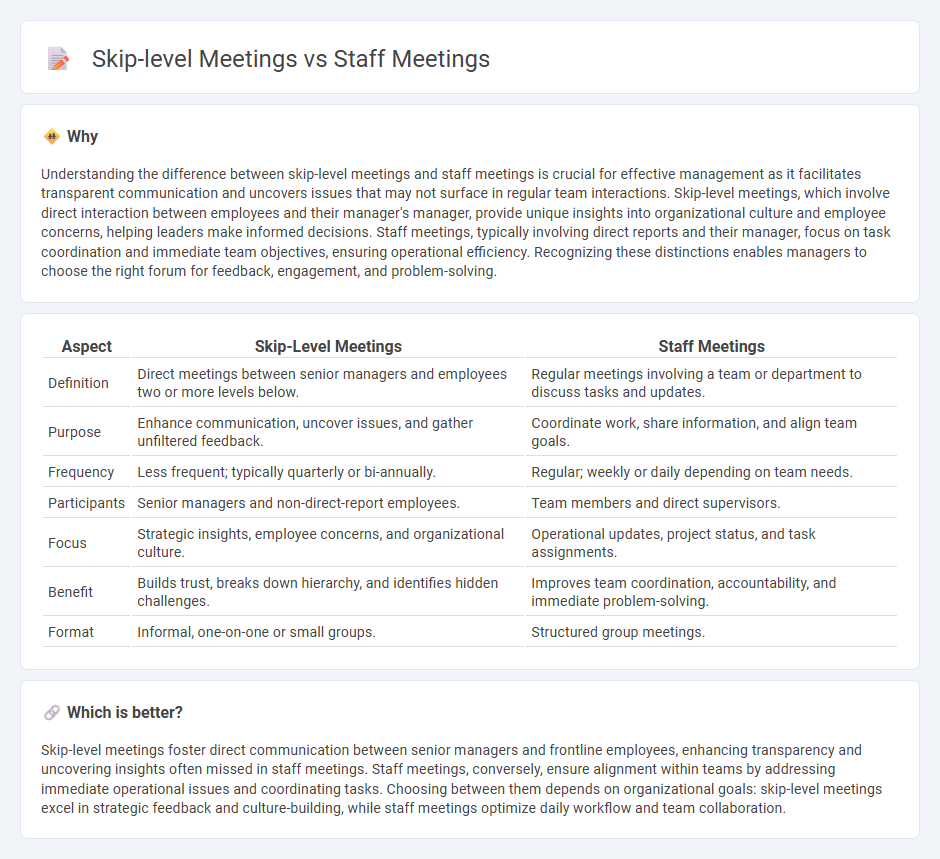
Skip-level meetings facilitate direct communication between senior managers and employees two or more levels below, bypassing immediate supervisors to gain unfiltered insights and foster transparency. Staff meetings typically involve direct team members and their immediate manager, focusing on routine updates, task coordination, and addressing team-specific issues. Explore the strategic advantages of integrating both meeting types to enhance organizational communication and employee engagement.
Why it is important
Understanding the difference between skip-level meetings and staff meetings is crucial for effective management as it facilitates transparent communication and uncovers issues that may not surface in regular team interactions. Skip-level meetings, which involve direct interaction between employees and their manager's manager, provide unique insights into organizational culture and employee concerns, helping leaders make informed decisions. Staff meetings, typically involving direct reports and their manager, focus on task coordination and immediate team objectives, ensuring operational efficiency. Recognizing these distinctions enables managers to choose the right forum for feedback, engagement, and problem-solving.
Comparison Table
| Aspect | Skip-Level Meetings | Staff Meetings |
|---|---|---|
| Definition | Direct meetings between senior managers and employees two or more levels below. | Regular meetings involving a team or department to discuss tasks and updates. |
| Purpose | Enhance communication, uncover issues, and gather unfiltered feedback. | Coordinate work, share information, and align team goals. |
| Frequency | Less frequent; typically quarterly or bi-annually. | Regular; weekly or daily depending on team needs. |
| Participants | Senior managers and non-direct-report employees. | Team members and direct supervisors. |
| Focus | Strategic insights, employee concerns, and organizational culture. | Operational updates, project status, and task assignments. |
| Benefit | Builds trust, breaks down hierarchy, and identifies hidden challenges. | Improves team coordination, accountability, and immediate problem-solving. |
| Format | Informal, one-on-one or small groups. | Structured group meetings. |
Which is better?
Skip-level meetings foster direct communication between senior managers and frontline employees, enhancing transparency and uncovering insights often missed in staff meetings. Staff meetings, conversely, ensure alignment within teams by addressing immediate operational issues and coordinating tasks. Choosing between them depends on organizational goals: skip-level meetings excel in strategic feedback and culture-building, while staff meetings optimize daily workflow and team collaboration.
Connection
Skip-level meetings enhance communication between management and frontline employees by bypassing direct supervisors, providing insights that can be discussed further in staff meetings to align team goals and address issues effectively. These meetings create a feedback loop where skip-level discussions inform staff meetings, ensuring top-level perspectives are integrated into everyday team operations. Integrating insights from skip-level meetings into staff meetings supports a transparent management culture and fosters employee engagement.
Key Terms
Agenda
Staff meetings typically follow a standardized agenda centered on team updates, project progress, and immediate operational issues to ensure alignment among direct reports. Skip-level meetings prioritize strategic discussions, employee feedback, and organizational culture insights, providing leaders with a broader perspective beyond their immediate team. Explore more to optimize your meeting agendas for enhanced communication and decision-making.
Hierarchy
Staff meetings typically involve direct reports and emphasize operational updates within a specific team or department, reinforcing immediate hierarchical relationships. Skip-level meetings bypass the direct manager, enabling higher-level leaders to engage with employees two or more levels down, fostering transparency across broader hierarchies. Explore how these meeting types influence organizational communication and leadership dynamics.
Communication
Staff meetings foster direct communication between managers and their immediate team, ensuring alignment on tasks and project updates. Skip-level meetings facilitate open dialogue by connecting employees with higher-level leaders, breaking communication barriers and revealing insights beyond direct supervisors. Explore effective communication strategies in both to enhance organizational transparency and engagement.
Source and External Links
Conducting Staff Meetings - Provides guidance on conducting effective staff meetings, including tips for maintaining a productive agenda and encouraging participation without domination.
Don't Neglect Routine Staff Meetings - Highlights the importance of regular staff meetings for maintaining open communication and preventing rumors.
How To Host an Effective Staff Meeting - Offers practical advice and do's and don'ts for hosting effective staff meetings, including agenda development and invitation strategies.
 dowidth.com
dowidth.com